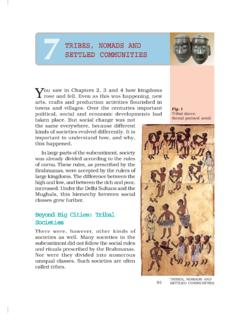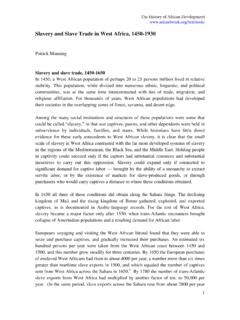Transcription of West African Society and Culture
1 GUIDE TO READING. How did west African Culture influence the way African Americans lived? What role did gender play in Section 3. west African Society the organization of west African village life? and Culture What were the principal features of the indigenous west africa 's great ethnic and cultural diversity makes it hazardous to religion of west africa ? generalize about the social and cultural background of the first African Americans. But historians have pieced together a broad understanding of the way the people of west africa lived at the beginning of the KEY TERMS Atlantic slave trade. patrilineal, p. 24. matrilineal, p. 24 Families and Villages polygynous, p. 25 By the early sixteenth century, most west Africans were farmers. They usu- indigenous, p. 26 ally lived in hamlets or villages composed of extended families and clans called lineages. Depending on the ethnic group involved, extended fami- griots, p.
2 28 lies and lineages were either patrilineal or matrilineal. In patrilineal soci- eties, social rank and property passed in the male line from fathers to sons. In matrilineal societies, rank and property, although controlled by men, passed from generation to generation in the female line. A village chief in a matrilineal Society was succeeded by his sister's son, not his own. But many west Africans lived in stateless societies with no government other than that provided by extended families and lineages. In extended families, nuclear families (husband, wife, and children). or in some cases polygynous families (husband, wives, and children). acted as economic units. Both kinds of family units existed in the con- text of the broader family community composed of grandparents, aunts, uncles, and cousins. Elders in the extended family had great power over the economic and social lives of its members.
3 In contrast with ancient Egypt, strictly enforced incest taboos prohibited people from marrying within their extended family. Guide to Reading/Key Terms For answers, see the Teacher's Resource Manual. Village Life Villages tended to be larger on the savannah than in the forest. In both Recommended Reading regions, people used forced earth or mud to construct small houses, Roland Oliver. The African Experience: Major which were round or rectangular in shape, depending on local tradi- Themes in African History from Earliest Times tion. The houses usually had thatched roofs, or, sometimes in the forest, to the Present. New York: HarperCollins, they had palm roofs. In both savannah and forest, mud or mud-brick 1991. Short, innovative, and insightful walls up to 10 feet high surrounded villages. A nuclear or polygynous analysis of cultural relationships. family unit might have several houses.
4 In nuclear households, the hus- 24 Chapter 1. band occupied the larger house and his wife the smaller. In polygynous households, the husband had the largest house, and his wives lived in smaller ones. Villagers' few possessions included cots, rugs, stools, and wooden storage chests. Their tools and weapons included bows, spears, iron axes, hoes, and scythes. Households used grinding stones, woven baskets, and a variety of ceramic vessels to prepare and store food. Villagers in both the savannah and forest regions produced cotton for clothing, but their food crops were quite distinct. west Africans in the savannah cultivated millet, rice, and sorghum as their dietary staples; kept goats and cattle for milk and cheese; and supplemented their diets with peas, okra, water- melons, and a variety of nuts. Yams, rather than grains, were the dietary staple in the forest region. Other important forest region crops included bananas and coco yams, both ultimately derived from far-off Indonesia.
5 Farming in west africa was not easy. Drought was common on the savannah. In the forest, where diseases carried by the tsetse fly sickened draft animals, agricultural plots were limited in size, because they had to be cleared by hand. The fields surrounding forest villages averaged just two or three acres per family. Although there was private ownership of land in west africa , people generally worked land communally, dividing tasks by gender. Among the Akan of the Guinea coast, for example, men were responsible for clearing the land of trees and underbrush while women tended the fields (planting, weeding, harvesting, and carrying in the harvested pro- duce). Women also took care of children, prepared meals, and manu- factured household pottery. Women In general, men dominated women in west africa . As previously noted, it was common for men to take two or more wives, and, to a degree, custom held women to be the property of men.
6 But west African women also enjoyed a relative amount of freedom that impressed Arab and European visitors. In ancient Ghana, women sometimes served as government officials. Later, in the forest region, women sometimes inherited property and owned land or at least controlled its income. Women including enslaved women in the royal court of Dahomey held high government posts. Ashante noblewomen could own property, although they themselves could be considered inheritable property. The Ashante queen held her own court to administer women's affairs. Women retained far more freedom in west africa than was the case in Europe or southwest Asia. Ibn Battuta, a Muslim Berber from North africa who visited Mali during the fourteenth century, was shocked to Retracing the Odyssey discover that in this Islamic country women show no bashfulness before Chattanooga African American Museum, men and do not veil themselves, though they are assiduous in attending Chattanooga, TN.
7 The museum includes an prayer. Battuta was even more dumbfounded to learn that in west exhibit dealing with African Culture and history. africa 25. africa women could have male friends and companions other than their husbands or relatives. Throughout the region secret societies instilled in men and women ethical standards of personal behavior. The most important secret soci- eties were the women's Sande and the men's Poro. They initiated boys and girls into adulthood. They also established standards for personal conduct, especially in regard to issues of gender, by emphasizing female virtue and male honor. Other secret societies influenced politics, trade, medical practice, recreation, and social gatherings. Class and Slavery Although many west Africans lived in stateless societies, most lived in hier- archically organized states headed by monarchs who claimed divine or semidivine status.
8 These monarchs were far from absolute in the power they wielded, but they commanded armies, taxed commerce, and accumulated considerable wealth. Beneath the royalty were classes of landed nobles, war- riors, peasants, and bureaucrats. Lower classes included blacksmiths, butch- ers, weavers, woodcarvers, tanners, and the oral historians called griots. Slavery had been part of this hierarchical social structure since ancient times. Although it was very common throughout west africa , slavery was less so in the forest region than on the savannah. It took a wide variety of forms and was not necessarily a permanent condition. Like people in other parts of the world, west Africans held war captives including men, women, and children to be without rights and suitable for enslavement. In Islamic regions, masters had obligations to their slaves similar to those of a guardian for a ward and were responsible for their slaves' religious well- being.
9 In non-Islamic regions, the children of slaves acquired legal protec- tions, such as the right not to be sold away from the land they occupied. Slaves who served either in the royal courts of west African king- doms or in the kingdoms' armies often exercised power over free peo- ple and could acquire property. Also, the slaves of peasant farmers often had standards of living similar to those of their masters. Slaves who worked under overseers in gangs on large estates were far less fortunate. However, even for such enslaved agricultural workers, the work and priv- ileges accorded to the second and third generations became little dif- ferent from those of free people. Regardless of their generation, slaves retained a low social status, but in many respects slavery in west African Recommended Readings societies functioned as a means of assimilation. John Thornton. africa and Africans in the Making of the Atlantic World, 1400 1689.
10 New York: Cambridge University Press, 1992. A thorough Religion consideration of west African Culture and its There were two religious traditions in fifteenth-century west africa : impact in the Americas. Islamic and indigenous. Islam, which was introduced into west africa by John S. Mbiti. An Introduction to African Religion. Arab traders and took root first in the Sudanese empires, was most preva- London: Heinemann, 1975. lent in the more cosmopolitan savannah. Even there it was stronger in 26 Chapter 1. cities than in rural areas. Islam was the religion of merchants and bureau- crats. It fostered literacy in Arabic, the spread of Islamic learning, and the construction of mosques in the cities of west africa . west africa 's indigenous religions remained strongest in the forest region. They were polytheistic and animistic, recognizing a great num- ber of divinities and spirits. Beneath an all-powerful, but remote, creator god were lesser gods who represented the forces of nature.






